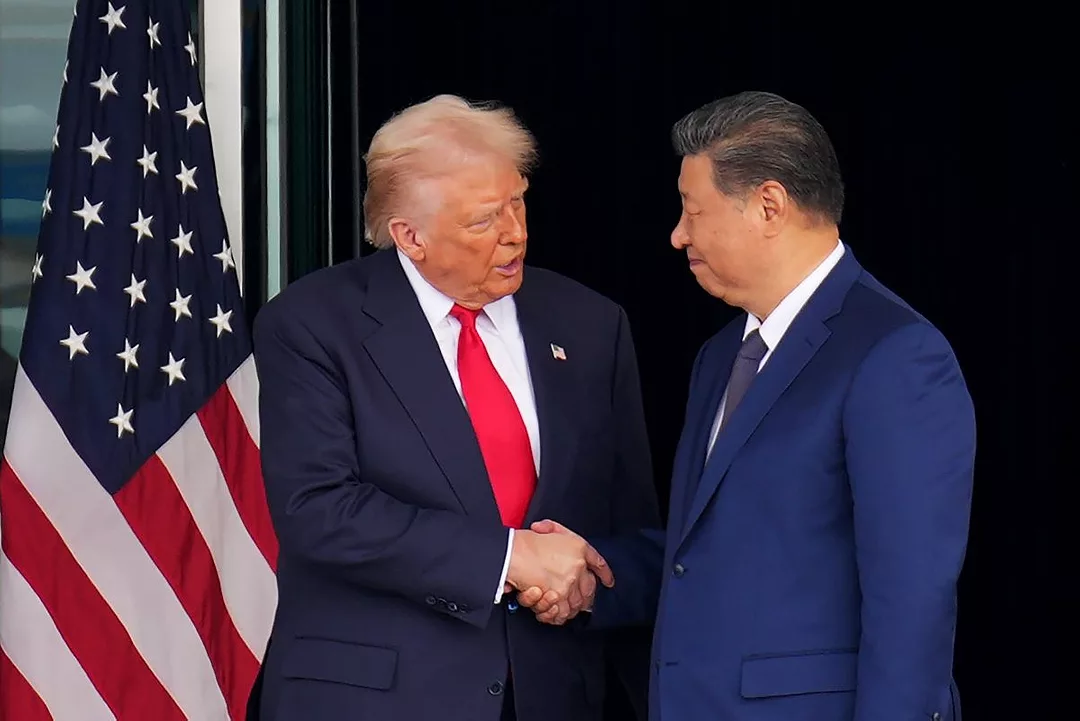World
Trump and Xi Reach Temporary Agreement on Rare Earth Exports

In a significant diplomatic engagement, U.S. President Donald Trump and Chinese President Xi Jinping reached a temporary agreement regarding rare earth minerals during their first meeting since Trump resumed office in January. This agreement is seen as a crucial step in addressing one of the most contentious issues in U.S.-China trade relations.
Trump announced that both leaders had successfully “settled” their differences on rare earths, which are vital to various industries, including defense and technology. “There’s no roadblock at all on rare earth,” Trump stated aboard Air Force One, expressing optimism that this issue would soon be resolved. The immediate outcome of the discussions includes China delaying the implementation of stringent export controls for a year, a move that could have significant implications for global supply chains.
Details of the Agreement and Implications
While Trump characterized the agreement as a win for both the global economy and the United States, it is essential to note that this deal merely postpones the introduction of new export restrictions that China had planned. These export controls are critical for the production of fighter jets, semiconductors, and electric vehicles. The U.S. and global companies will continue to rely heavily on China for these essential materials, indicating that further negotiations will be necessary for a more comprehensive resolution.
To facilitate this temporary truce, the U.S. agreed to delay its proposed expansion of an export blacklist that could have targeted thousands of Chinese firms. More than 24 hours after the meeting, the White House had not released a detailed summary of the agreements made, while the Chinese Ministry of Commerce issued a document on October 30, 2025, outlining their perspective on the accord.
Jamieson Greer, U.S. Trade Representative, acknowledged that the negotiations did not yield significant changes to China’s existing export controls. He described the situation as a continuation of an understanding that had previously been violated by Beijing. “We have some rare earth controls from earlier in the year on magnets, where we got to a decent flow, but now we expect them to flow even better,” Greer told reporters following the meeting.
Concerns from Industry Experts
Despite the hopeful tone from U.S. officials, some analysts expressed skepticism regarding the effectiveness of the agreement. Derek Scissors, a China expert at the American Enterprise Institute, criticized the U.S. approach, suggesting that it reflects a heavy dependence on Chinese markets, particularly from the automotive and agricultural sectors.
“American policy since China’s April magnet controls looks like Germany’s long-term China policy: Both run by a few automakers which are dependent on China, yet get to dictate what the whole government does,” Scissors remarked.
Critics argue that the U.S. has effectively linked its own high-tech export restrictions to China’s rare earth controls, which could set a concerning precedent. Chris McGuire, an expert on China and emerging technologies, expressed his concerns about the implications of this negotiation strategy, highlighting the risks involved in conceding to Chinese demands.
The deal represents a one-year ceasefire in the imposition of new controls, but experts warn that the existing restrictions remain in place. Additionally, since U.S. measures require frequent updates to remain effective, they may inadvertently benefit China more in the long run.
China first implemented export restrictions on rare earth magnets in April 2025, leading to a series of retaliatory measures from the U.S. As Trump approached this week’s meeting, he had considered more aggressive tariffs but ultimately rolled back that threat, along with tariffs linked to Beijing’s role in the fentanyl trade.
As a result, the average tariff rate on Chinese goods may decrease to 31%, making production in China more attractive compared to other countries like Brazil and India. The implications of this shift could hinder Trump’s goal of reshaping supply chains to reduce reliance on Chinese manufacturing.
While Trump and Xi plan to continue discussions in 2026, the immediate future remains uncertain. There are concerns that the recent agreement may not lead to tangible changes for industries reliant on rare earth materials. Wade Senti, president of Advanced Magnet Lab Inc., noted that the current landscape for industries dependent on rare earth imports remains largely unchanged.
The ongoing challenges facing U.S. industries that depend on rare earth elements underline the complexities of international trade negotiations. Companies continue to report delays and difficulties in obtaining the necessary export licenses from China, leaving many in a precarious position.
As the situation evolves, industry experts warn that the concessions made by the U.S. could amount to a temporary fix rather than a sustainable solution. The effectiveness of this agreement in altering the dynamics of U.S.-China trade relations remains to be seen, as both sides prepare for future negotiations.
-

 Business2 weeks ago
Business2 weeks agoIconic Sand Dollar Social Club Listed for $3 Million in Folly Beach
-

 Politics2 weeks ago
Politics2 weeks agoAfghan Refugee Detained by ICE After Asylum Hearing in New York
-

 Health2 weeks ago
Health2 weeks agoPeptilogics Secures $78 Million to Combat Prosthetic Joint Infections
-

 Science2 weeks ago
Science2 weeks agoResearchers Achieve Fastest Genome Sequencing in Under Four Hours
-

 Health2 weeks ago
Health2 weeks agoResearcher Uncovers Zika Virus Pathway to Placenta Using Nanotubes
-

 Science2 weeks ago
Science2 weeks agoInterstellar Object 3I/ATLAS Emits Unique Metal Alloy, Says Scientist
-

 Lifestyle2 weeks ago
Lifestyle2 weeks agoJump for Good: San Clemente Pier Fundraiser Allows Legal Leaps
-

 World2 weeks ago
World2 weeks agoUS Passport Ranks Drop Out of Top 10 for First Time Ever
-

 Business2 weeks ago
Business2 weeks agoSan Jose High-Rise Faces Foreclosure Over $182.5 Million Loan
-

 Entertainment2 weeks ago
Entertainment2 weeks agoJennifer Lopez Addresses A-Rod Split in Candid Interview
-

 Top Stories2 weeks ago
Top Stories2 weeks agoChicago Symphony Orchestra Dazzles with Berlioz Under Mäkelä
-

 World2 weeks ago
World2 weeks agoRegional Pilots’ Salaries Surge to Six Figures in 2025









